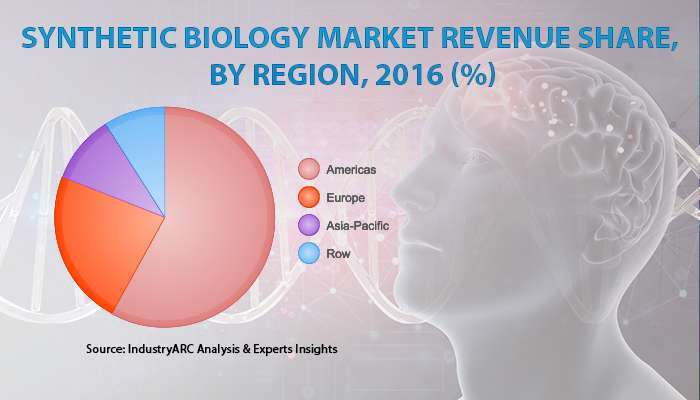Synthetic biology is an emerging area of biological research which combines both science and engineering. According to this research report from IndustryARC, the global synthetic biology market size was between $12.80 billion to $13.86 billion in 2018, and the market demand is projected to grow at a phenomenal CAGR of 36% to 38% during the forecast period of 2019 to 2025. North America is identified as the key region, chunking out 41% to 43% of the total demand in 2018 and poised to maintain its dominance. Factors such as increasing investment to harness possibilities with new synthetic biology technologies such as gene synthesis, genome engineering, cloning, sequencing, and nanotechnology, growing R&D funding, and collaborations are driving the growth of the synthetic biology market in this region.
- As world population is increasing day by day, conversely, the need for food is also increasing and the cultivation land is decreasing owing to industrialization. Using synthetic biology techniques, farmers can yield more crops in low cultivation land due to their properties such as more efficient plant use of water and nutrients, photosynthetic performance, nitrogen fixation and better resistance to pests are developed using synthetic biology.
- Artemisinin is an antimalarial medicine which will be now produced from yeast using synthetic biology; avoiding the need to isolate it from Chinese sweet wormwood plant. This will help to stabilize global medicine prices and increases and the demand for synthetic biology market in the medical sector.
- Globally, cancer is the second leading cause of death which is responsible for an estimated 9.6 million deaths in 2018. According to World Health Organization, about 1 in 6 deaths are due to cancer. Advancement in genome engineering such as CRISPR and DNA synthesis technologies will reduce the risks from cancer and driving the growth of the synthetic biology market.
- The construction and testing process of biological systems is complicated and irregular; which became the major challenge for the growth of the market. However, to solve this problem, Ginkgo Biological Studio developed an automation system which can combine the gene components together.
- The misuse of synthetic biology or possibilities of accidental release of pathogens into free atmosphere is another key challenge for the market. But, rising demand for bio-fuels, and investments on synthetic drugs and vaccines would further offer profitable growth chances in the market.
- In order to create larger functional architecture by synthetic biology, device modularization and standardization become a necessity. However, the non-linear and uncertain nature of systems biology makes standardization of parts as a non-trivial task which in turn propels the growth of the market.

- Biomonitoring is another exciting area for synthetic biology developments. Highly specific, tiny biosensors can be engineered to spot an enormous range of molecules such as hydrocarbon pollutants, sugars, heavy metals, and antibiotics in environmental sensing systems.
- Synthetic biology also used in agricultural applications to provide more precision and sophistication than earlier gene technologies. This helps to increase crop and livestock yields, while reducing environmental impact by limiting the use of chemicals and fertilizers.
- OPX Biotechnologies (OPXBIO) is developing renewable bio based acrylic to match petro-acrylic performance and cost but with a 75 percent reduction in greenhouse gas emissions. BioAcrylic from OPXBIO also will reduce oil-dependence and offer more stable prices.
- North America: The U.S., Canada, Mexico
- South America: Brazil, Venezuela, Argentina, Ecuador, Peru, Colombia, Costa Rica
- Europe: The U.K., Germany, Italy, France, The Netherlands, Belgium, Spain, Denmark
- APAC: China, Japan, Australia, South Korea, India, Taiwan, Malaysia, Hong Kong
- Middle East and Africa: Israel, South Africa, Saudi Arabia










Comments (0)
Post a Comment